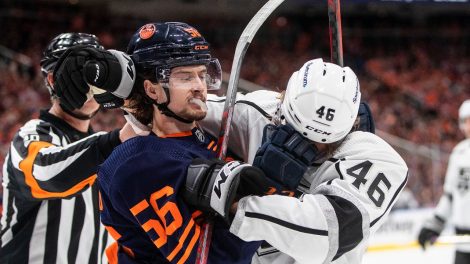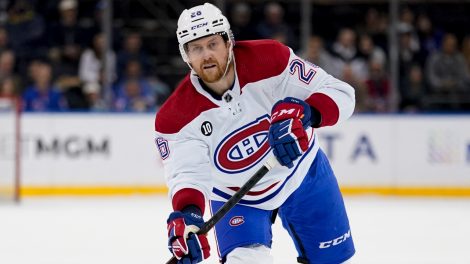It’s been nearly a month since the trade deadline came and went, and most of the teams that made moves have had somewhere in the neighbourhood of 10-plus games to test out their new lineups. While some of the acquisitions were made with eyes firmly fixated on a playoff run, others were done with the intention of providing a shot in the arm to get over the hump and make it there to begin with.
Armed with the benefit of hindsight and a modest (but growing) sample, let’s take a look at a couple additions that have most notably thrived in their new homes.
[snippet id=3317857]
PAUL STASTNY, WINNIPEG JETS
The fact Patrik Laine was expected to miss up to two weeks after hurting his foot blocking a shot the other day is a disappointing development to say the least.
This is especially true considering how well he’d been playing prior to going down, scoring 18 goals and 26 points in a 15-game scoring streak. Selfishly, watching Laine go shot for shot with Alex Ovechkin for the Rocket Richard crown would’ve made for great theatre and provided yet another storyline to follow in the waning days of the regular season.
There is a silver lining here for the Jets, though. They’ve afforded themselves plenty of breathing room in the standings and look destined to head into the playoffs as the second seed in the Central Division. This sets them up for a first-round matchup in which they’ll have home-ice advantage against either the Wild, Avalanche, or possibly Blues.
All that matters at this point is that Winnipeg gets everything lined up and ready to go for the start of that series in the second week of April, by which time Laine should be back in the lineup and firing on all cylinders from the wing.
Assuming that’s the case, the Jets certainly look poised to be a nightmare match up for whoever has the bad fortune of drawing them. A big reason why is the addition of Paul Stastny at the deadline, which provided Winnipeg with another certifiably potent scoring line for opponents to contend with.
| Metric | Ehlers-Stastny-Laine Combo |
|---|---|
| Time on Ice | 109.46 |
| Shot Attempts % | 59.0 |
| Shots on Goal % | 55.6 |
| Scoring Chance % | 60.2 |
| Goal Differential | 13-3 |
| Expected Goals % | 56.6 |
(All Data at 5-on-5)
In Stastny’s 10 games with the team, he’s fit like a glove. On paper, it made sense that the individual skill sets of those three would complement each other from the jump, and it’s been reassuring to see it seamlessly translate on to the ice.
Ehlers’ puck retrieval and speed coming through the neutral zone has pushed defenders back, creating an additional layer of breathing room for the others to operate. Stastny has done a bit of everything, most notably knowing exactly where the puck needs to be and when it needs to get there. Fortunately for him, when the Jets enter the attacking zone the answer becomes obvious: ‘on Patrik Laine’s stick.’
Because of a variety of injuries, we haven’t really been able to see this Jets team fully healthy and at the peak of their powers for any extended period since the deadline. If they manage to get healthy by Game 1 of the Stanley Cup playoffs, look out.
EVANDER KANE, SAN JOSE SHARKS
The Sharks found themselves in a rather precarious position at the deadline. They clearly needed to do something to help improve their roster, because despite sitting in a playoff spot on Feb. 26, they were doing it with a rather underwhelming group that was just sort of plodding along.
Considering how much the Sharks have invested in this core of players, they owed it to themselves to take at least one more kick at the can this post-season before reevaluating and potentially reloading in a big way with the vast amounts of salary cap space they’ll have available in the summer.
The issue is they’re not exactly flush with young disposable assets, and even if they were, the roster wasn’t inspiring enough to warrant an all-in approach at this year’s deadline.
As it turns out, Evander Kane was the perfect half measure. With his reputation around the league having completely cratered his value on the trade market, Kane presented GM Doug Wilson and the Sharks with the type of ideal low risk, high reward gamble they needed to make.
Since acquiring Kane, the Sharks have taken off, winning nine of 11 games, including six in a row, and outscoring their opposition by a 45-26 margin. Beyond just the wins and goals, the underlying five-on-five profile has just as importantly spiked in the right direction as well:
| Metric | Before Deadline | After Deadline |
|---|---|---|
| Games Played | 63 | 11 |
| Shot Attempts % | 51.3 | 54.5 |
| Shots on Goal % | 50.7 | 55.4 |
| Goals For % | 46.5 | 63.2 |
| Expected Goals For % | 50.6 | 58.8 |
A couple of caveats: the quality of competition hasn’t exactly been overwhelming. In that post-deadline span they’ve only had to go up against two playoff teams and two bubble teams, mostly feasting on a couple of their in-division cellar dwellers. It’s also remarkable what a wild fluctuation in shooting percentage can do to change the outlook on things.
As a team the Sharks were 26th in 5-on-5 offence prior to the trade, largely due to a 7.26 per cent conversion rate. Since then the goals they’ve generated per hour have risen from 2.03 to 3.54 (which is tops in the league), backed by an 11.79 per cent clip.
Considering Kane has always been more of a volume shooter than a percentage driver, it’s more likely this is either a regression that would’ve happened anyways, or a blip on the radar. Whatever the driving force is, it’s a welcome change for a team that was uncharacteristically starved for offence. And while the timing of it seems coincidental, it surely doesn’t hurt that they added another legitimate weapon to a group that didn’t have too many of them.
To his credit, Kane has fit in rather nicely. Playing on Joe Pavelski’s wing on the top line, Kane’s been as advertised, generating a ton of shots and scoring five goals in 11 games (including a four-goal outburst in a big game on the road against the Flames). If and when Joe Thornton is able to come back, head coach Peter DeBoer will have some intriguing options up front. The combination of Thornton as a playmaker and Kane as the trigger man is intriguing, as is the capability of experimenting with either keeping Pavelski down the middle and rolling with three scoring lines, or moving him back to the wing and loading up the top-six.
Regardless of how it all plays out, the calculated risk San Jose took on Kane was sound. If he flames out and things unravel, they can walk away from him this summer having only surrendered a second- and fourth-round pick (neither of which are even in this year’s draft). If it turns out that he desperately needed a change of scenery and benefits from playing for a winning team for the first time in his career, then bumping that price up from a second-rounder to a first-rounder by re-signing him is a small price to pay for a spirited playoff run and a 30-goal scorer still in his prime.
[snippet id=3918715]
JT MILLER, TAMPA BAY LIGHTNING
After the dust settled, the biggest winner of the trade deadline may very well have been JT Miller. Jumping from a sinking Rangers ship to the cushiest of landing spots on the Lightning’s top line, he must be loving the income tax-free, sunshine-filled life of a Florida resident.
After having initially started out on a line with Brayden Point and Yanni Gourde (both of whom are excellent young players having terrific breakout campaigns), Miller’s since been bumped up to the role of riding shotgun with Nikita Kucherov and Steven Stamkos.
As it turns out, when you’re first and seventh in NHL points respectively, you tend to attract all sorts of attention from the opposing defence. To Miller’s credit he’s made the most of the resulting freedom and air space with which to operate, doing a good job of hanging around dangerous scoring areas and making himself available for whenever he’s needed:
In his 11 games with the Lightning, Miller has exploded for seven goals and 12 points. Three of those tallies have come on the power play, where prior to this year he’d never scored more than two in a single season (though he did have six goals on the man advantage with the Rangers prior to being traded).
Most of his work has shared that common theme, as he’s made a living crashing the net and being the grateful recipient of Tampa Bay’s wonderful puck movement:
Will Miller continue converting more than one out of every four of his shots into goals? No. But if he can stick in this cushy role, he should be able to continue generating all sorts of crazy counting stats. He can parlay that into a productive playoff run, followed by a relatively lucrative payday this off-season, when he’ll be arbitration eligible.
Apologies to Vlad Namestnikov, whose talent I’m actually quite fond of. He’s surely better than what he’s shown thus far in New York, generating just two goals, one assist, and 19 shots in 11 games. But part of the reason the Lightning were so willing to flip him in a deal was because he was similarly about to cash in this summer based on the role he was playing, and not what he was actually worth.
Whenever you’re feeling sad, just imagine how Namestnikov must feel seeing Miller slide into his old gig so seamlessly, remembering all of the good times he enjoyed as the third wheel with two of the most prolific offensive players in the game.
Thanks to Corsica and Natural Stat Trick for being the source for the data used in this piece, and Cap Friendly for being an invaluable resource when it comes to referencing any and all transaction information.
[relatedlinks]







